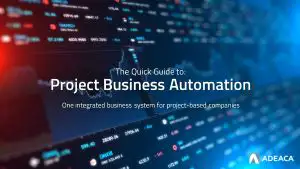If you are in a project industry, such as engineering and construction, ETO manufacturing, or professional services, you are a Project Business.
Identifying as a Project Business will help you prioritize and optimize your business activities and investments properly. You’ll be able to clearly understand how you should structure your business and what systems and solutions are possible. Unifying your core Project Business activities and setting up your Project Business structure will give you the foundation to scale, grow, diversify and increase profitability.
The Way Forward for Project Business
In order to improve the way traditional industries have for the last 30 years, Project Businesses need to govern their business activities in the same way other traditional industries have. But I don’t mean “corporate governance.” I mean controlling your business processes to optimize business performance. Let’s start with what are the core activities for a project business.
Activities in which every Project Business engages:
| Project Management & Operations |
|
| Project Financials & Accounting |
|
| Project Analytics |
|
| General |
|
If you’re a construction business, you may think, “What about my BIM?” If you’re an engineering contractor you may want to know where design and CAD fit in. If you’re a manufacturer, you may be asking, “What about PLM and supply chain?” Those are all important parts of your specific industry; however, if you don’t have the fundamental project business processes working, it won’t matter how well your PLM system runs or if your estimating tool works.
Once we look at the fundamentals this way, we can start to see:
- Why the business isn’t running as well as it could
- Where the problems are
- What we need to do to solve them
For most Project Businesses, the lack of standardization and integration is the key problem. This boils down to process engineering and governance. We need to create the structure that will set up the company for success.
How do we do that?
Step 1: Standardize
Companies in traditional industries have their processes and data standardized. This allows them to govern their business effectively and produce reliable, consistent metrics to measure business performance in any area.
Project Business has a standardization problem. Processes aren’t uniform, and they rely on individuals who take extreme liberties with them. As a result, it is difficult to control the business functions and create standard metrics to measure performance. Therefore, the first step is to standardize processes around best practices and data to derive consistent metrics.
Step 2: Integrate
Companies in traditional industries have all their processes and data integrated. That is how a Retailer uses demand information captured at the point of sale to drive supply chain decisions. Traditional businesses understand that in order to save time and information throughout the business’value chain, it’s critical that processes and data are integrated.
Typically with Project Business, processes and data are dispersed among numerous people, departments and systems. That said, the next step is to unify and integrate workflows across all departments and business units. We need to integrate data into a single source of truth that everyone can rely on. Only by integrating our processes and data can we achieve company alignment toward strategic goals.
Step 3: Systemize and Automate
The last step is to systemize the first two. Retail, Manufacturing and Distribution companies employ Retail, Manufacturing or Distribution solutions and systems that take care of their core business. This ensures that processes are followed, and data are integrated. That is how that Retailer automatically places a new order with a supplier based on real-time POS data.
Most Project Businesses are not set up this way. Project Businesses end up with a disparate landscape of disconnected systems and applications. Processes and data end up in various spreadsheets, project management/time-keeping applications, the ERP and CRM, a separate data warehouse, etc.
This makes it extremely difficult for Project Businesses to improve and be productive. They end up trying to optimize all these systems and processes separately. This only exacerbates the core issue because processes and data become even more entrenched in their separate status quo.
Systemizing processes and data across the company codifies standardized procedures and integrates information in real time. The system enforces the standardization and integration for you. As a result, your Project Business becomes fully aligned as an organization and you know exactly how the business is performing at all times.
These three steps create the process and project governance structure that allows Project Businesses to operate with similar transparency and control as traditional industries.
Check out this Infographic: Project Governance Simplified in 3 Steps for more detail on this.
Project Business Automation
At Adeaca, we believe in Project Business as a fundamental business type that needs its own type of solution, just like Retail or Distribution. We put the essential project business activities into a unified system that sets up this structure and aligns the company. We call this Project Business Automation (PBA).
PBA helps you run, manage and organize all critical areas and controls of your project business. At its core, Project Business Automation standardizes and integrates your processes and data to bring you trusted, real-time insight and enhanced collaboration practices that lead to more projects on time and within budget. And, improving your Project Business is what it is all about.











